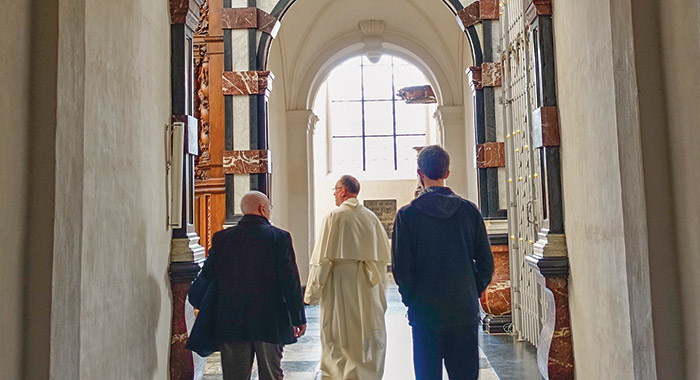Belgian Abbey Visit Aids Research
When Luke Manderle ’18 and Alex Gruber ’18 applied for research fellowships at the Center for Norbertine Studies (CNS), they knew the opportunity would require two things: the study of Norbertine heritage, and foreign travel.
They enjoyed both of those Jan. 3-17, visiting four Norbertine abbeys in Belgium in company with the Rev. Andrew Ciferni, O.Praem., ’64, director of the CNS. The threesome also stopped at Daylesford Abbey in Paoli, Pa., and Archmere Academy, the Norbertine prep school in Claymont, Del.
The trip was part of the center’s effort to digitize archives pertaining to the missionary activity of all Norbertine abbeys and make them available online. The students helped digitize correspondence between early-20th-century Grimbergen missionaries on a failed mission in Canada – letters to their parents, and to the abbot and prior of the Belgian abbey.
“Probably the most important part for me was the people we met,” says Manderle, who plans to teach high school history. “They were all amazing, really nice people. All of them were really interesting, too.”
Gruber, who plans to be an archivist, says, “I really found interesting the richness of spirituality and history, and how much people appreciated it over in Belgium, and I think in Europe in general.” He cites governments working with orders to maintain abbeys and their heritage.
Gruber says “wow!” was his first thought when entering the church of Grimbergen Abbey. It was built in the 1600s. The Baroque experience was almost overwhelming to the student visitors at first, he added, but noticed that local residents were “so used to it that it’s easy for them to walk in and sit down.”
The abbey church of Grimbergen dates from 1660 and the interior is richly decorated in the Baroque style of the time. Gruber says, “We have impressive churches in the United States, but we don’t have authentic Baroque architecture with all the gold filigree, and all the huge paintings that just hang on the walls as if they’ve been there forever, and massive statues and columns everywhere.”
“It is kind of overwhelming,” Manderle adds. “It almost seems a little excessive the first time going through it because, just coming from here and the kind of plain churches, to going over there – just all of the, everything, it’s kind of crazy, but a good distraction during the Mass in a language I couldn’t understand!”
Although Ciferni has often visited Grimbergen , the experience was a treat for him, too. “In addition to the experience of the three of us working together on the same level playing field as amateur archivists, the great gift to me was once again experiencing these wonderful Norbertine places and communities through Luke and Alex’s first-time experience of wonder and surprise.”
The priest, who knows both Dutch and French, began going to Grimbergen in 1965 as a student in Rome, but only learned last July about its doomed mission in Canada.
At Grimbergen, Ciferni and a former abbot of the Belgian foundation worked with Gruber and Manderle to record into a spreadsheet basic information about some 2,000 letters documenting the mission’s history. They then scanned the letters.
The visitors joined in abbey life, attending prayers in Dutch and eating with the Norbertines, who were more than ready to converse in English for the sake of their guests. The trio also visited Averbode, Park and Tongerlo abbeys. And they were able to call on Frans Debonne, a Norbertine associate living in Belgium and longtime collector of Norbertine-related items. (We introduced readers to Debonne and his collection in our Spring 2013 issue.)
Ciferni hopes that, by semester’s end, Manderle and Gruber will be able to finish the technical portion of their project and that they will introduce their findings to the broader community at the college’s Undergraduate Research Forum at the end of March.
April 17, 2015












